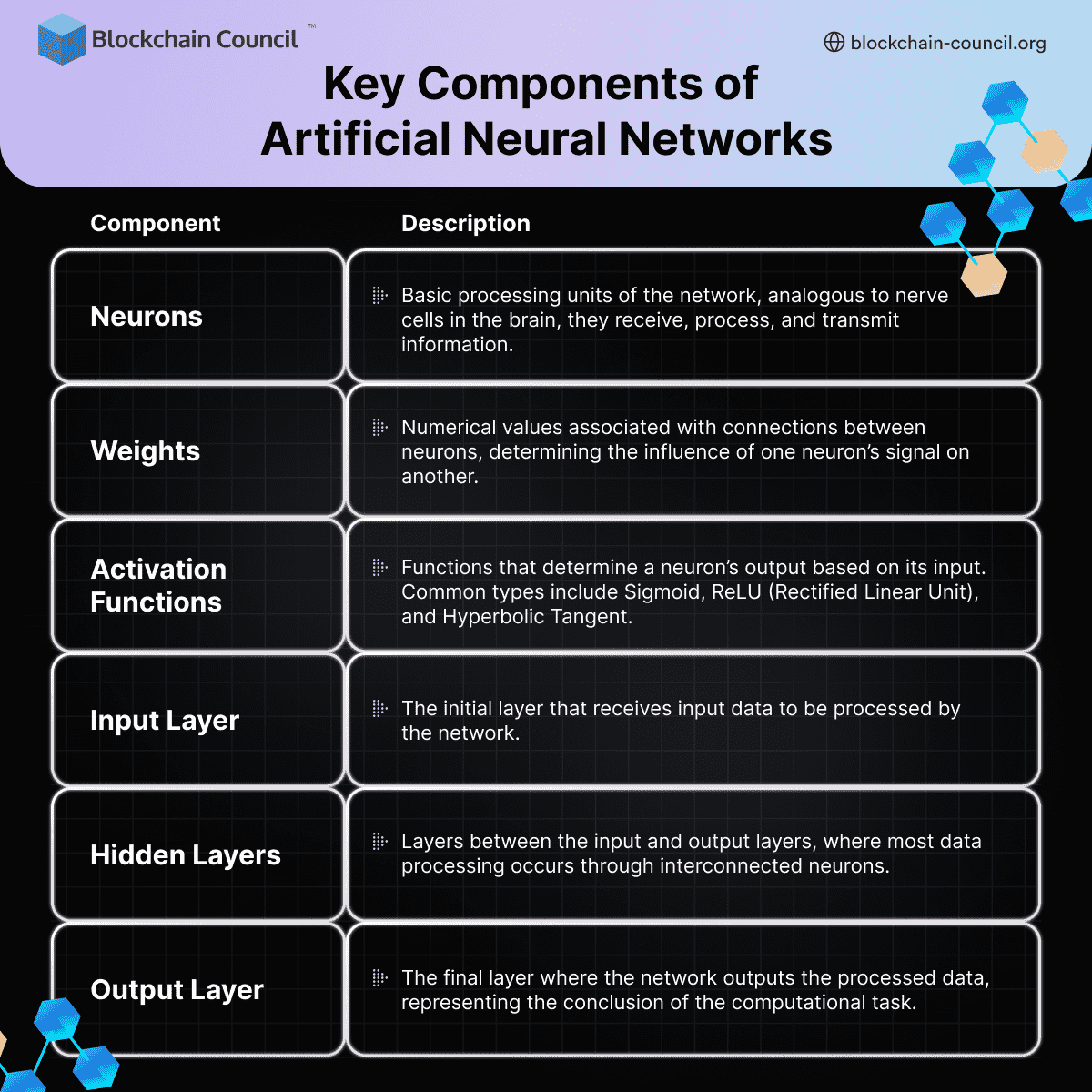
- Blockchain Council
- February 06, 2025
Summary
- Convolutional Neural Networks (CNNs) are crucial in the field of artificial intelligence, particularly for analyzing visual imagery.
- CNNs are designed to automatically learn spatial hierarchies of features from input images, making them effective in tasks like image classification and object detection.
- The article provides a comprehensive guide to CNNs, from their fundamentals to advanced concepts.
- Artificial Neural Networks (ANNs) are computational models inspired by the human brain and form the basis for CNNs.
- CNNs consist of key components, including neurons, weights, activation functions, input layer, hidden layers, and output layer.
- Feedforward and backpropagation processes are essential for training ANNs, including CNNs.
- CNNs have core components like convolutional layers, ReLU layers, pooling layers, and fully connected layers.
- These components enable CNNs to automatically learn features at various levels of abstraction from input images.
- CNNs require data preprocessing and augmentation for effective image analysis.
- The future of CNNs involves expanding applications beyond visual data, innovations in training and model architecture, addressing current challenges, and integration with other AI domains.
In the ever-evolving world of artificial intelligence and machine learning, Convolutional Neural Networks (CNNs) have emerged as a pivotal technology. CNNs, a class of deep neural networks, are predominantly used in analyzing visual imagery. They are distinguished by their unique structure which includes convolutional layers that automatically and adaptively learn spatial hierarchies of features from images. This attribute makes them incredibly effective for tasks in computer vision, such as image classification, object detection, and face recognition.
The significance of CNNs in the realm of machine learning and artificial intelligence is profound. They represent a monumental shift from traditional programming to systems that can understand and interpret the visual world, mirroring human cognitive abilities.
This comprehensive guide aims to provide you with a deep understanding of CNNs, from the basics to advanced concepts. By the end of this article, readers will have a comprehensive understanding of CNNs, appreciating their role and impact in driving forward the fields of AI and machine learning.
Fundamentals of Neural Networks
Artificial Neural Networks
Artificial Neural Networks (ANNs) are computational models inspired by the human brain. These networks comprise multiple layers of nodes, including an input layer, several hidden layers, and an output layer. The connections between nodes, akin to synapses in a biological brain, transmit signals, thereby facilitating various tasks like pattern recognition, classification, and data analysis. The essence of an ANN lies in its ability to learn from data, adapting its internal structure of interconnected nodes or neurons to optimize performance for specific tasks.
Key Components of ANNs
Overview of Feedforward and Backpropagation Processes
Feedforward is the process where input data moves through the layers of an ANN to produce an output. Each neuron in a layer receives input from the previous layer, processes it, and passes it on. This is akin to the flow of information in the human brain from sensory input to a response.
Backpropagation is a key learning mechanism in ANNs. It involves adjusting the weights of neurons based on the error between the predicted output and the actual output. The process iteratively improves the network’s accuracy, making it better at tasks like pattern recognition or data classification.
Convolutional Neural Networks (CNNs)
Convolutional Neural Networks (CNNs) stand out in the realm of deep learning, especially for tasks involving images. Their architecture is distinctively structured to capitalize on the two-dimensional nature of images. A typical CNN architecture flows from an input layer to various hidden layers and finally to an output layer. These hidden layers include convolutional layers, pooling layers, and fully connected layers, each playing a unique role in the network.
Key Components of CNNs
- Convolutional Layer: This layer is the heart of a CNN. It uses filters to transform the input image into outputs known as activation maps. These filters slide across the input image, applying a convolution operation at each step, effectively capturing features like edges, textures, etc.
- ReLU Layer: Standing for Rectified Linear Unit, this layer applies a non-linear operation. Its primary role is to introduce non-linearity into the network, allowing the network to learn more complex patterns.
- Pooling Layer: This layer reduces the spatial size of the representation, decreasing the number of parameters and computation in the network. It also helps in making the detection of features invariant to scale and orientation changes.
- Fully Connected Layer: In this layer, neurons have full connections to all activations in the previous layer. It’s typically placed before the output layer and helps in deriving the final output from the features learned by the network.
Concept of Feature Learning in CNNs
CNNs are designed to automatically and adaptively learn spatial hierarchies of features from input images. The early layers capture basic features like edges and blobs, while deeper layers in the network interpret these basic features to learn more complex representations. This automatic feature extraction makes CNNs highly efficient for tasks like image recognition and classification.
By progressively learning and combining these features, CNNs can handle complex visual tasks, making them a cornerstone of modern computer vision applications. Their ability to learn features at various levels of abstraction allows them to adapt to a wide range of visual tasks without needing hand-engineered features.
How Convolutional Neural Networks (CNNs) Work
Convolutional layers, often considered the “eyes” of CNNs, are where the primary processing of input images occurs. These layers use small, square grids known as filters or kernels to scan over the input image. Each filter is designed to detect specific features, such as edges, textures, or shapes. During the convolution process, these filters slide across the image, applying a dot product operation at each position and generating a feature map. This feature map is a new representation of the input, highlighting where specific patterns (detected by the filter) are located.
The convolutional operation is crucial for CNNs as it allows the network to learn various features from the input image. For instance, a 3×3 kernel sliding over an image will process the image in small sections, each time producing a single output number that contributes to the feature map. These operations are repeated across the entire image, ensuring that the network comprehensively analyzes the input.
Role of Pooling Layers: Max Pooling and Average Pooling
Following the convolutional layers are the pooling layers, which serve to reduce the spatial dimensions (height and width) of the input volume for the next convolutional layer. Pooling layers help in decreasing the computational power required to process the data through dimensionality reduction. Moreover, they also help in extracting dominant features which are rotational and positional invariant, thus maintaining the process of effectively training the model.
The two common types of pooling are max pooling and average pooling. Max pooling returns the maximum value from the portion of the image covered by the kernel, whereas average pooling computes the average of all values in the kernel area. This process results in pooled feature maps that have reduced dimensions but still retain the most critical information from the input.
The Flattening Process and Fully Connected Layers
After several convolutional and pooling layers, the high-level reasoning in the neural network is done by fully connected layers. In a fully connected layer, neurons have full connections to all activations in the previous layer. Before data is fed into these fully connected layers, it must be flattened into a vector. This vector then serves as the input for the fully connected layers, where the back-end processing of the CNN occurs.
The fully connected layers combine all the learned features from the previous layers (which might be local or global features, depending on their depth in the network) for the final classification. The last layer in a CNN is typically a softmax layer, which classifies the input image into various classes based on the training dataset.
Loss Functions and Optimizers in CNNs
In training CNNs, loss functions and optimizers play a crucial role. The loss function measures how well the model is performing, or in other words, how close the model’s predictions are to the actual labels. Common loss functions used in CNNs include cross-entropy loss and mean squared error.
Optimizers, on the other hand, are algorithms or methods used to change the attributes of the neural network, such as weights and learning rate, to reduce the losses. Optimizers help the network to converge more quickly to a minimum loss. Popular optimizers used in CNNs include Stochastic Gradient Descent (SGD), Adam, and RMSprop.
The combination of these components enables CNNs to effectively learn from image data, making them highly effective for tasks in computer vision, such as image classification, object detection, and more.
Convolutional Neural Networks (CNNs) in Practice
Preparing Data for CNNs: Image Preprocessing and Augmentation
Effective data preparation is key to the success of Convolutional Neural Networks (CNNs) in image analysis. Two critical steps in this process are image resizing and normalization, and data augmentation.
- Image Resizing and Normalization: CNNs generally require a fixed input size for images. Standard dimensions like 224×224 or 256×256 pixels are commonly used. Normalizing pixel values to a range, such as [0, 1], is also crucial. This standardization involves adjusting pixel values so they fall within a specific range, enhancing the model’s ability to process the data efficiently.
- Data Augmentation: To enhance the robustness and generalizability of CNNs, data augmentation techniques are employed. This involves creating variations of the training images through transformations like random rotations, flipping, zooming, and adjustments in brightness and contrast. These techniques not only help in expanding the dataset but also in preventing overfitting, thus improving the model’s performance on unseen data.
Step-by-Step Guide to Building a Basic CNN Model
Building a CNN model typically involves defining the architecture and selecting appropriate layers and parameters. Here’s a simplified overview using a framework like TensorFlow’s Keras:
- Define the Model: Start by creating a sequential model and adding layers to it.
import tensorflow as tf
from tensorflow.keras import layers
model = tf.keras.Sequential([
layers.Conv2D(32, kernel_size=(3, 3), activation=’relu’, input_shape=(224, 224, 3)),
layers.MaxPooling2D(pool_size=(2, 2)),
layers.Flatten(),
layers.Dense(128, activation=’relu’),
layers.Dense(num_classes, activation=’softmax’)
])
- Configure the Model: This involves specifying the optimizer, loss function, and metrics for the training process.
- Train the Model: Feed the prepared and preprocessed data into the model and optimize the parameters to minimize the loss.
- Evaluate and Fine-Tune: Assess the model’s performance using metrics like accuracy and make necessary adjustments.
Example with a Popular Dataset: MNIST
Creating a Convolutional Neural Network (CNN) model for the MNIST dataset is a classic exercise in deep learning. The MNIST dataset consists of handwritten digits (0 through 9) and is widely used for training and testing in the field of machine learning. Here’s a step-by-step guide to building a CNN model for MNIST using TensorFlow and Keras:
- Import Libraries and Load the Dataset:
import tensorflow as tf
from tensorflow.keras.datasets import mnist
from tensorflow.keras import layers
(train_images, train_labels), (test_images, test_labels) = mnist.load_data()
- Preprocess the Data:
- Reshape the data to include a channel dimension (since MNIST is grayscale, there is only one channel).
- Normalize the pixel values.
train_images = train_images.reshape((60000, 28, 28, 1))
test_images = test_images.reshape((10000, 28, 28, 1))
# Normalize pixel values to be between 0 and 1
train_images, test_images = train_images / 255.0, test_images / 255.0
- Build the CNN Model:
- Create a simple CNN model using Keras.
model = tf.keras.Sequential([
layers.Conv2D(32, (3, 3), activation=’relu’, input_shape=(28, 28, 1)),
layers.MaxPooling2D((2, 2)),
layers.Conv2D(64, (3, 3), activation=’relu’),
layers.MaxPooling2D((2, 2)),
layers.Conv2D(64, (3, 3), activation=’relu’),
layers.Flatten(),
layers.Dense(64, activation=’relu’),
layers.Dense(10, activation=’softmax’)
])
- Compile the Model:
- Use the Adam optimizer and sparse categorical crossentropy as the loss function.
model.compile(optimizer=’adam’,
loss=’sparse_categorical_crossentropy’,
metrics=[‘accuracy’])
- Train the Model:
- Fit the model to the training data.
model.fit(train_images, train_labels, epochs=5)
- Evaluate the Model:
- Test the model’s performance on the test dataset.
test_loss, test_acc = model.evaluate(test_images, test_labels)
print(‘Test accuracy:’, test_acc)
- Make Predictions:
- Use the trained model to make predictions on new data.
predictions = model.predict(test_images)
This example provides a basic framework for building a CNN model for the MNIST dataset. The architecture used here includes three convolutional layers followed by max pooling layers, a flattening step, and two dense layers. The activation function ‘relu’ is used in the convolutional and first dense layer, while ‘softmax’ is used in the final dense layer to output probabilities for the 10 digit classes.
Use cases of Convolutional Neural Networks (CNNs)
- Facial Recognition in Social Media: CNNs have revolutionized facial recognition technology, now widely used in social media platforms. They enhance user experience by automating photo tagging and enabling interactive features like facial filters. This application showcases CNNs’ ability to identify and analyze complex features such as facial shapes, skin tones, and textures.
- Medical Image Computing: CNNs are making groundbreaking contributions to healthcare, particularly in medical image analysis. They exhibit superior accuracy in identifying anomalies in X-rays and MRI images compared to traditional methods. CNNs in medical imaging not only display a series of images but also highlight differences, aiding predictive analytics in healthcare.
- Health Risk Assessment: In healthcare, CNNs are employed for predictive analytics in health risk assessment. They use grid topology for data processing and convolution algorithms to identify critical aspects of input data, thus aiding in forecasting health outcomes and potential treatment plans.
- Drug Discovery: CNNs are significantly optimizing the drug discovery process, making it more scalable and cost-effective. They play a crucial role in various stages like hit discovery, hit to lead process, and lead optimization, accelerating the development of new drugs.
- Precision Medicine: CNNs are integral to precision medicine, providing personalized treatment plans based on patient data. They analyze a wide range of variables affecting patient states, helping in forming comprehensive treatment strategies.
Future of Convolutional Neural Networks (CNNs)
The future of Convolutional Neural Networks (CNNs) is marked by promising trends and potential challenges, leading to transformative impacts across various domains.
Expanding Applications Beyond Visual Data
CNNs, traditionally dominant in image processing, are increasingly being applied to non-visual data types. This includes text and audio processing, where their ability to detect hierarchical patterns is proving beneficial. For example, in text analysis, CNNs can discern semantic patterns at various levels, from characters to sentences, offering advanced capabilities in sentiment analysis, language translation, and topic categorization. Similarly, in audio processing, CNNs are effective for tasks like speech recognition and sound classification, leveraging their proficiency in analyzing time-series data.
Innovations in Training and Model Architecture
Efficient and effective training of CNNs remains a crucial area of development. Innovations like Batch Normalization and attention mechanisms are enhancing learning processes and convergence rates. Batch Normalization standardizes inputs to layers for each mini-batch, stabilizing learning and accelerating deep network training. Attention mechanisms, initially introduced in the Transformer model, are being integrated into CNN architectures, improving the network’s focus on relevant features, especially in complex tasks like visual question answering and image captioning.
Advancements in Unstructured Data Environments
CNNs are evolving to handle unstructured data environments like irregular graphs or social networks, traditionally challenging for their grid-like data structure. Graph Convolutional Networks (GCNs) are a significant development in this direction, extending the concept of convolution to graph-structured data, enabling effective feature extraction from these environments.
Addressing Current Challenges and Limitations
Several challenges confront CNNs, including the heavy reliance on large, labeled datasets, overcoming biases to ensure fairness in training, enhancing model interpretability, and improving resilience against adversarial attacks and data noise. Addressing these issues is crucial for the broader adoption and ethical application of CNNs.
Integration with Other AI Domains
There’s an emerging trend of combining CNNs with other AI techniques like reinforcement learning and generative models, expanding their capabilities beyond traditional applications. This integration is expected to lead to more sophisticated models capable of tackling complex tasks across various fields.
Computational Approaches
The computational aspect, particularly the hardware used for training and deploying CNNs, plays a significant role in their evolution. The effectiveness of different computational tools like CPUs, GPUs, and FPGAs directly impacts the efficiency and scalability of CNN models.
Conclusion
Convolutional Neural Networks stand as a testament to the remarkable progress in artificial intelligence and machine learning. From their inception as simple neuron models to their evolution into sophisticated architectures capable of mimicking human-level perception, CNNs have transformed how machines interpret visual data. They are not just tools for image recognition but are pivotal in advancing numerous fields like healthcare, autonomous vehicles, and facial recognition technologies.
As we look towards the future, CNNs are poised to continue evolving, becoming more efficient, and finding new applications in various sectors. Their journey reflects the broader trajectory of AI – one that is marked by continuous learning, adaptation, and an ever-expanding horizon of possibilities. As we continue to explore and innovate in this space, CNNs will undoubtedly play a central role in shaping the future of technology and its application in our daily lives.
Disclaimer: The content on this platform is for educational purposes only. We do not endorse, recommend, or promote any product. Our articles are based on data from trustworthy sources, and our perspective is neutral and unbiased. Readers should make informed decisions and seek professional advice when needed. We have no affiliations with the products or services mentioned in our content.
Frequently Asked Questions
What is the significance of Convolutional Neural Networks (CNNs) in artificial intelligence and machine learning?
- CNNs are pivotal for analyzing visual data, such as images, and excel in tasks like image classification, object detection, and face recognition.
- They represent a shift from traditional programming to systems capable of understanding and interpreting visual information like humans.
- CNNs are essential for various applications in healthcare, autonomous vehicles, social media, drug discovery, and more.
- Their ability to automatically learn features from images makes them highly efficient and adaptable to a wide range of tasks.
How do Convolutional Neural Networks (CNNs) work, and what are their core components?
- CNNs consist of layers, including convolutional layers that apply filters to input images, generating feature maps.
- ReLU layers introduce non-linearity, allowing the network to learn complex patterns.
- Pooling layers reduce spatial dimensions while preserving essential information.
- Fully connected layers combine learned features for classification.
- CNNs automatically learn spatial hierarchies of features, starting from basic features like edges to more complex representations.
What is the process of building a Convolutional Neural Network (CNN) model?
- Define the model architecture, specifying layers and parameters.
- Configure the model by selecting an optimizer, loss function, and metrics.
- Train the model by feeding it preprocessed data and optimizing parameters.
- Evaluate the model’s performance on a test dataset.
- An example for the MNIST dataset involves data preprocessing, model definition, compilation, training, evaluation, and prediction.
What are the future trends and challenges in Convolutional Neural Networks (CNNs)?
- CNNs are expanding beyond visual data to non-visual types like text and audio processing.
- Innovations in training and model architecture, such as Batch Normalization and attention mechanisms, are enhancing learning.
- CNNs are adapting to handle unstructured data environments like irregular graphs.
- Challenges include reliance on large labeled datasets, biases in training data, model interpretability, and resilience against adversarial attacks.
- Integration with other AI domains and advancements in computational approaches will shape the future of CNNs.






































































 Guides
Guides News
News Blockchain
Blockchain Cryptocurrency
& Digital Assets
Cryptocurrency
& Digital Assets Web3
Web3 Metaverse & NFTs
Metaverse & NFTs
